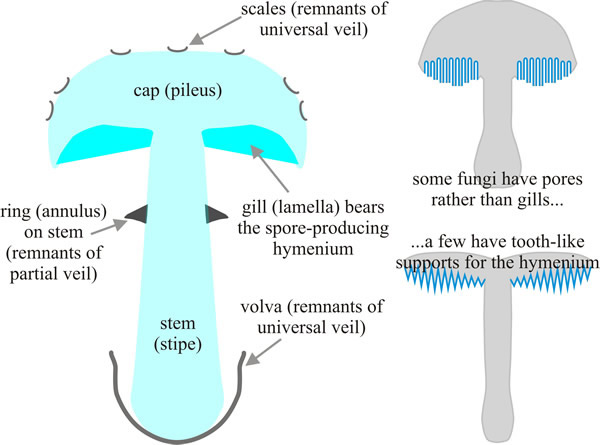12.3 The observational and experimental basis of fungal developmental biology
A great many of the experiments we will mention describe development of the mushroom fruit body (Fig. 1, for example) so we should first warn that this is where you suffer the prejudices and preferences of your authors; we focus on Basidiomycota because that’s our interest!
The mushroom is a spore-dispersal organ that is umbrella-shaped to protect the spore-release process from rain (hydrophobic interactions with a droplet of watery fluid liberate basidiospores (Section 9.8), this can’t happen in the rain). Fig. 2 shows a sketch diagram of the typical mushroom structure as seen in a vertical section. The spores form on cells in a hymenium that lines the under surface of the mushroom cap. The surface area covered by hymenium is increased by the under surface of the cap being divided into vertical plates (the gills), closely-packed tubes (pores), or tooth-like spikes. Increasing the surface area covered by hymenium has selective advantage because it increases the reproductive capacity of the structure, and it has evolved independently several times in different phylogenies.
 |
| Fig. 2. Main tissues of a mushroom. The mushroom is our main example, it is a spore-dispersal organ that is basically umbrella-shaped, with the spore-bearing hymenium lining the under surface of a cap (also called pileus) and supported above the substratum by the stem (= stipe), shown in this diagrammatic vertical section. The mature mushroom may also bear remnants of thin tissues (veils) that protect the juvenile stages. The text discusses how this mushroom structure is produced. |
The geometrical proportions of the stem (short and stocky, or long and slender) vary with the demands of this support function: large caps require more substantial stems, etc. But they also vary with the demands of the ecology and habitat of the species: short stems may be appropriate in species that form fruit bodies on bare soil, but those that characteristically come up into copious plant litter or amongst heavy plant cover may depend on tall stems to lift the cap into an air flow. As well as the geometry, these structural considerations also determine the internal anatomy of the stem: tall and slim stems tend to be anatomically hollow cylinders at maturity; very short and stocky stems tend to be constructed of solid tissue when mature. The stem, however, has more to do than simply support the cap physically; it must also support the cap physiologically. All the nutrients and all the water the cap needs to shape itself and produce its crop of spores are supplied by the mycelium and must be translocated through the stem.
The anatomical pattern that we recognise as ‘a mushroom’ (Fig. 2) result from differential growth and morphogenesis of the component tissues of the developing mushroom ‘embryo’ (Fig. 1). The rest of this Chapter will be devoted to showing how these mushroom structures are produced but we will have to deal with just a few specific cases to do this and we first want to make the point that there are a wide variety of differential growth patterns that generate the tremendous morphological diversity evident among the fruit bodies of these higher fungi.
| For the price of a Coffee & Coffee
Cake ($5) you can
buy yourself a PDF file of this chapter from 21st Century
Guidebook to Fungi Online. Our PDFs feature an elegantly simple text layout that is easily readable on your mobile or other device, and all hyperlinks are live so you can continue to enjoy the Internet experience. Chapter 12: Development and morphogenesis. The following appendix items are attached to this chapter: Don Emmeluth’s Latin and Greek Derivations; Ten ways to make a mushroom; and Genomic systems analysis of fungi starter references, making a 74-page PDF file priced at FIVE US$ ($5) Delivered to you by SendOwl Not convinced yet? Download a FREE sample HERE  |
Updated July, 2019
